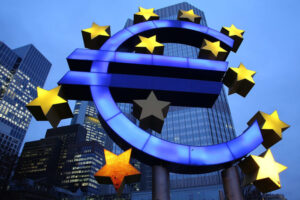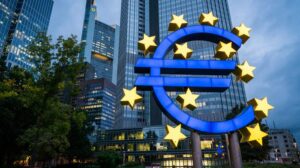
The eurozone economy grew by 0.1% in the second quarter of 2025 compared to the previous three months and by 1.4% year-on-year, according to revised data from the EU statistics office (Eurostat). The figures were in line with previous estimates and analysts’ expectations.
In January-March, the eurozone’s GDP grew faster, by 0.6% quarter-on-quarter and 1.1% year-on-year.
Ranking of eurozone countries by GDP growth in Q2 (quarter-on-quarter)
Overall, the EU economy grew by 0.2% in the second quarter and 1.5% year-on-year.
Among the largest economies in the eurozone, Germany and Italy showed a moderate decline, while France and Spain showed significant growth. The largest increase was recorded in Romania, and the largest decline was in Ireland.
This is the second estimate of the change in eurozone GDP out of three; Eurostat will present the final data on September 5.
Earlier, the information and analytical center Experts Club made a video analysis of the prospects for the Ukrainian and global economies. For more details, see the video — https://youtu.be/kQsH3lUvMKo?si=F4IOLdLuVbYmEh5P

Unemployment in the eurozone stood at 6.2% in June, according to the European Union’s statistical office. In May, according to the revised data, it was also at 6.2%, not 6.3%, as previously reported. Analysts on average expected unemployment to remain at the previously announced May level, according to Trading Economics.
For comparison, in June 2024, the unemployment rate was 6.4%.
Unemployment was at a record low of 6.2% in October and November 2024, then rose, and in April fell again to the lowest level on record.
In June, the number of unemployed in the euro area decreased by 62 thousand compared to the previous month, to 10.7 million people.
The share of unemployed youth (population under 25) fell to 14.1% from 14.3%.
The lowest unemployment rate among the largest eurozone countries was recorded in Germany (3.7%), and the highest in Spain (10.4%).
In the European Union, unemployment remained at 5.9% in June. In the same month of 2024, it was 6%.

Consumer prices (CPI) in the eurozone rose by 2% year-on-year in June, according to final data from the European Union’s statistical office. This represents an acceleration from 1.9% in May (the lowest rise in eight months).
The figure was in line with previously announced data and the consensus forecast of analysts cited by Trading Economics.
Consumer price growth in the eurozone is close to the European Central Bank’s target, indicating that the regulator has managed to bring inflation under control.
The rise in prices for services in the eurozone accelerated to 3.3% last month from 3.2% in May. The cost of food, alcohol, and tobacco rose 3.1% after a 3.2% increase in May. Energy prices fell 2.6% after dropping 3.6% a month earlier, while industrial goods rose 0.5% (in May – 0.6%).
Consumer prices excluding food and energy (Core CPI) rose by 2.3% year-on-year in June, the same as a month earlier. This was in line with both previously announced rates and experts’ expectations.
The CPI index in June rose by 0.3% compared to the previous month.
Source: http://relocation.com.ua/acceleration-of-inflation-in-the-eurozone/

The eurozone’s GDP in the fourth quarter of 2024 increased by 0.1% compared to the previous three months, according to a report by the European Union’s statistical office, which presented revised data. Previously, it was reported that GDP remained unchanged. Experts on average expected the previous estimate to be confirmed, according to Trading Economics.
In annual terms, the eurozone economy grew by 0.9%, the fastest pace since the beginning of 2023. The dynamics of this indicator coincided with the previous estimate and the consensus forecast of analysts.
In the third quarter, eurozone GDP increased by 0.4% compared to the previous three months and by 0.9% in annual terms.
In October-December, Germany’s economy declined by 0.2% quarter-on-quarter, France’s by 0.1%, Spain’s by 0.8%, and Italy’s GDP remained unchanged.
In annual terms, Germany’s GDP also decreased by 0.2%, France’s by 0.7%, Spain’s by 3.5%, and Italy’s by 0.5%.
In the fourth quarter, the EU economy grew by 0.2% compared to the previous three months and by 1.1% in annual terms.
This is the second estimate of GDP dynamics for the fourth quarter out of three. The third estimate will be published on March 7. According to preliminary data, in 2024, the euro area’s GDP grew by 0.7%, and the EU’s by 0.9%.
Experts Club Analytical Center and Maksim Urakin released earlier video analysis about the economy of Ukraine and the world – https://youtu.be/LT0sE3ymMnQ?si=b_tVU8Zeg_-xZVEo.
Source: http://relocation.com.ua/vvp-yevrozony-v-iv-kvartali-zris-na-01/

Stock indices of the largest countries of Western Europe in the course of trading on Wednesday show a positive mood on the data on weakening inflation in the UK and the eurozone.
The composite index of the largest European companies Stoxx Europe 600 increased by 0.4% to 462.45 points by 12:02 Q2.
German indicator DAX from the market opening rose by 0.2%, French CAC 40 – by 0.6%, British FTSE 100 – by 1.5% (to the maximum for a month). Italian FTSE MIB and Spanish IBEX 35 added 0.15% each.
Consumer prices in the UK in June rose by 7.9% in annualized terms – this is the minimum rise since March 2022. Inflation thus slowed from 8.7% in May.
The consensus forecast cited by Trading Economics had called for inflation to weaken to 8.2% in June.
Consumer price growth in Britain in monthly terms slowed to 0.1% in June from 0.7% in May. Analysts had expected an increase of 0.4%.
Consumer prices in the euro zone rose at a 5.5% annualized rate in June, according to final data. This is the weakest rise since January last year. Inflation was 6.1% in May.
The June figure matched both the preliminary estimate and the average forecast of experts.
Dutch manufacturer of chip equipment ASML Holding NV reduced net profit by 1% in the second quarter, but improved its revenue growth forecast for the current year. Quotes of the company’s shares are up 0.5%.
The price of securities Kering SA soared by almost 6%. The French holding company, which owns famous fashion brands, announced the departure of Gucci CEO Marco Bizzarri, who held the post since 2015. The brand will be led on an interim basis by group managing director Jean-François Palus.
Swedish access control systems maker Assa Abloy increased its second-quarter net profit by 13.3% to 3.57 billion kronor ($349 million) and revenue by 17% to 34.47 billion kronor. Analysts polled by FactSet had on average forecast 4.13 billion crowns and 33.68 billion crowns, respectively. The company’s shares are up 0.2%.
Stock prices of oil producers are also rising: BP Plc and Shell – by 1.1%, TotalEnergies – by 0.5%.
Meanwhile, the value of Volvo is down 1.7%. The Swedish truck maker reported a 5% rise in deliveries in the April-June quarter, but new orders fell 10%.
Antofagasta shares are down 1.1%. The company increased copper production by 2.5% in the second quarter relative to January-March to 149.6 thousand tons. However, the forecast for the whole current year was lowered to 640-670 thousand tons from previously expected 670-710 thousand tons.

Unemployment in 19 countries of the eurozone in August did not change compared to July and amounted to 6.6%, which is the lowest figure in the entire history of its calculation, according to the data of the Statistical Office of the European Union.
Analysts also predicted that the indicator would remain at the same level, according to Trading Economics.
By comparison, unemployment was 7.5% in August 2021.
The number of unemployed in the euro area last month amounted to 10.966 million people, having decreased by 30 thousand people over the month.
Youth unemployment (population under 25) dropped to 13.9% from 14% in July. The number of unemployed in this age category decreased by 17 thousand compared to the previous month, to 2.136 million people.
The highest unemployment rate among European countries was recorded in Spain (12.4%) and Greece (12.3%). The lowest unemployment rate was recorded in the Czech Republic (2.4%), Poland (2.6%) and Germany (3%).
In the European Union, unemployment remained at 6% in August (6.8% in August 2021). In total, 12.921 million unemployed people were registered in the bloc, which is 52 thousand less than in July.